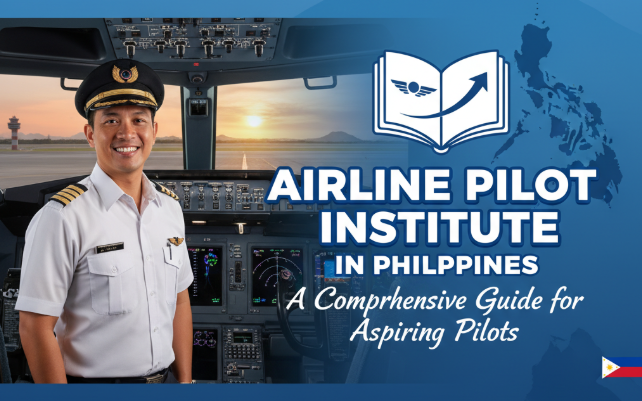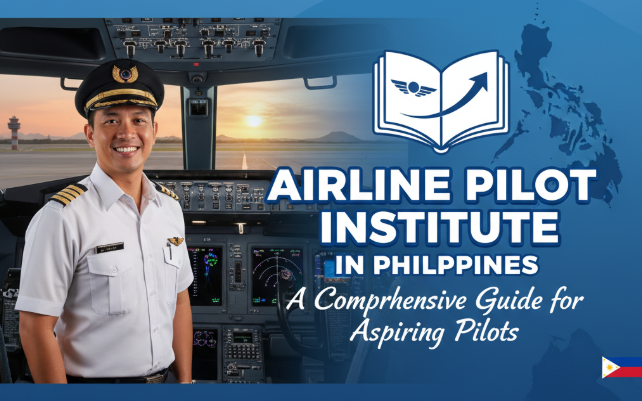
Aviation is an integral part of the global transportation network, and the Philippines, with its growing aviation industry, plays a significant role in this dynamic sector. As the demand for skilled pilots continues to rise, aspiring aviators are looking towards pilot institutes in the Philippines for their education and training. This blog will provide an in-depth overview of the Airline Pilot Institute in the Philippines, including its history, importance, eligibility requirements, and career opportunities. We’ll also discuss the future of aviation and pilot training in the Philippines, the challenges faced, and the opportunities available in this promising field.
Introduction to Airline Pilot Institute in Philippines
An Airline Pilot Institute in the Philippines is an educational institution dedicated to training individuals who aspire to become commercial pilots. These institutes offer a wide range of programs designed to equip students with the skills and knowledge needed to excel in the aviation industry. They provide comprehensive training in both the technical and practical aspects of piloting aircraft, including flight theory, navigation, aerodynamics, aviation law, and safety protocols.
The pilot program typically involves extensive ground school training followed by practical flight training, where students learn to handle aircraft in real-world scenarios. Upon completion, graduates are usually eligible for various pilot certifications, including the Commercial Pilot License (CPL), Airline Transport Pilot License (ATPL), and other specialized ratings.
What Is a Pilot Program?
A Pilot Program refers to an educational curriculum focused on training students to become licensed pilots. The program is structured to include both theoretical and practical training, with emphasis on flying techniques, aerodynamics, navigation, and aviation regulations. In the Philippines, pilot programs are offered by accredited aviation schools, flight academies, and training centers.
Importance of Aviation in Philippines
Aviation plays a crucial role in the Philippines’ economy, with a significant contribution to the tourism industry, international trade, and logistics. The Philippines is an archipelago with over 7,000 islands, making air travel an essential mode of transportation. The aviation industry provides millions of jobs, supports international connectivity, and boosts the country’s economic development.
As the demand for skilled pilots continues to grow, airline pilot institutes in the Philippines have become essential in ensuring that the aviation sector remains staffed with highly qualified professionals. These institutes not only support the national aviation industry but also contribute to the global aviation community by producing internationally recognized pilots.
History and Development of Aviation in Philippines
The history of aviation in the Philippines dates back to the early 20th century. The first successful flight in the country was made in 1910 by a French pilot, Henri Giraud, who flew a monoplane from Manila to the neighboring province of Cavite. Since then, aviation in the Philippines has evolved significantly.
Early Aviation History of the Philippines
In 1927, the Philippine Aerial Taxi Company was established, becoming the country’s first commercial airline. By the 1930s, commercial air travel had gained momentum, with major airlines such as Philippine Airlines (PAL) being founded in 1941. This laid the foundation for the Philippines to become a hub for both domestic and international aviation.
Milestones in Aviation
The Philippines has seen remarkable developments in its aviation history:
- 1941: The establishment of Philippine Airlines (PAL) as the first airline in the country.
- 1973: The Philippines joined the International Civil Aviation Organization (ICAO), boosting its aviation safety and regulatory standards.
- 1990s: The Philippines became a major hub for international air traffic, particularly with the rise of low-cost carriers.
- 2000s and beyond: The Philippines has expanded its aviation infrastructure with modern airports and more airlines, increasing international routes.
Current Role of Airline Pilot Institute in Philippines
Today, Airline Pilot Institutes in the Philippines play a pivotal role in shaping the future of aviation. These institutions provide a structured pathway for individuals to become professional pilots, ensuring that the aviation industry has a steady supply of well-trained personnel.
How These Institutions/Programs Function Today
Modern-day airline pilot institutes combine both traditional classroom learning and hands-on training using advanced flight simulators and real aircraft. These institutes collaborate closely with major airlines, aviation authorities, and regulatory bodies to ensure that their training programs meet international standards.
They also offer specialized programs such as flight instructor courses and aviation management training, enabling students to pursue various career paths within the aviation sector.
Role in Civil Aviation, Defense, and Space Exploration
Apart from training commercial pilots, these institutions contribute to the development of military aviation and the exploration of new fields such as space tourism. The rise of private space companies and government space programs (such as the Philippine Space Agency’s PhilSA) opens new avenues for aspiring pilots and space enthusiasts, with training programs specifically designed for spacecraft pilots and astronaut candidates.
Eligibility, Training, and Skills Required
Becoming a pilot in the Philippines requires meeting specific eligibility criteria, completing rigorous training, and developing both technical and soft skills.
Basic Qualifications
- Education: A high school diploma is generally required, but a bachelor’s degree in aviation or a related field is often preferred.
- Health: Candidates must pass a medical examination to ensure they are physically and mentally fit to fly.
- Age: Applicants must be at least 17 years old to start flight training and at least 21 years old to obtain an Airline Transport Pilot License (ATPL).
Technical and Soft Skills
- Technical Skills: Knowledge of aerodynamics, navigation, meteorology, and aviation regulations.
- Soft Skills: Communication, leadership, decision-making, and problem-solving are essential for pilots.
Institutes, Academies, and Training Centers in Philippines
The Philippines boasts several reputable aviation schools and flight academies that offer comprehensive training programs. Here are some notable institutions:
- Philippine Airlines Aviation School (PALAS)
- Known for its world-class training programs and partnership with Philippine Airlines.
- The University of the Philippines – Aviation
- Offers a degree program in aviation, with specialized training in aircraft operation and management.
- Aviation Institute of the Philippines
- Provides both undergraduate and postgraduate training in aviation fields.
- Airlink International Aviation School
- A leading aviation school offering pilot training, aviation management, and flight instructor programs.
- Cebu Pacific Flight School
- Provides training programs aimed at producing future pilots for the airline industry.
Government Initiatives
The Philippine government has also recognized the importance of aviation and has supported initiatives to enhance pilot training through the Civil Aviation Authority of the Philippines (CAAP), which sets regulatory standards for pilot training and ensures safety protocols. Moreover, national programs like the Philippine Space Agency (PhilSA) are developing initiatives to train pilots for space-related careers.
Technology and Innovation in Aviation Training
The aviation training landscape in the Philippines has greatly benefited from advancements in technology. Flight simulators have become an essential part of pilot training, providing a safe and controlled environment for students to practice real-world scenarios. Modern aviation schools also use cutting-edge technologies such as digital cockpits and artificial intelligence to enhance training experiences and improve the precision of flight training.
Global Agencies and Innovations
Institutions in the Philippines stay up-to-date with global innovations in aviation by aligning their training standards with international bodies such as:
- NASA
- ISRO
- ESA (European Space Agency)
- CNSA (China National Space Administration)
- Roscosmos (Russian Space Agency)
These collaborations ensure that Filipino pilots are trained with the latest technology, positioning them as competitive candidates in the global aviation industry.
Challenges Faced in Pilot Training in Philippines
Despite the growth of aviation training institutions in the Philippines, several challenges remain:
Infrastructure Gaps
While many pilot schools have modernized their facilities, there are still gaps in infrastructure, particularly in remote areas of the Philippines. These gaps can impact the accessibility and quality of training.
Costs
Pilot training is expensive, and the financial burden can be a barrier for many aspiring pilots. However, some institutes offer scholarships or financing options to help alleviate these costs.
Regulatory Hurdles
The Philippine aviation industry is subject to various regulations that can sometimes slow down the certification process, making it more difficult for new pilots to enter the workforce quickly.
Brain Drain
A significant number of pilots trained in the Philippines seek opportunities abroad due to higher salaries and better career prospects. This has led to a shortage of pilots within the country, despite the growing number of aviation schools.
Future of Airline Pilot Institute in Philippines
The future of airline pilot training in the Philippines looks promising, with the industry set to benefit from innovations in space tourism, private aviation, and artificial intelligence in cockpit training. Furthermore, the development of national space programs like the Philippines’ space agency, PhilSA, opens new avenues for pilot training in space exploration.
National Projects and Global Collaborations
The Philippines could also participate in global space missions such as NASA’s Artemis Program or China’s CNSA lunar projects, providing new career paths for Filipino pilots.
Career Path & Opportunities
Aspiring pilots in the Philippines can follow a structured career path:
- Education: Complete a degree or a diploma in aviation.
- Pilot License: Obtain a Private Pilot License (PPL), followed by the Commercial Pilot License (CPL) and Airline Transport Pilot License (ATPL).
- Advanced Training: Specialize in areas such as flight instructing, airline management, or even spacecraft piloting.
- Employment: Apply to local airlines like Philippine Airlines (PAL), Cebu Pacific, or international carriers.
Local Salary Expectations and Global Scope
A commercial pilot in the Philippines can expect a starting salary of PHP 50,000 – 100,000 per month, with experienced pilots earning more. However, many Filipino pilots choose to work abroad, where salaries are considerably higher.
FAQs (10-12 Q&A)
1. How much does pilot training cost in the Philippines?
Pilot training can cost between PHP 1.5 million – 3 million depending on the institution and the type of training program.
2. Which is the best aviation institute in the Philippines?
There are several reputable institutes, with Philippine Airlines Aviation School and Airlink International Aviation School being among the best.
3. What qualifications are needed for pilot training in the Philippines?
Applicants must have a high school diploma, pass a medical exam, and meet the age requirement of 17 years old for basic training.
4. Is international flight training available in the Philippines?
Yes, several institutes in the Philippines offer training programs recognized internationally, including by ICAO.
5. What is the future of aviation in the Philippines?
The future looks promising, with advancements in space tourism, private aviation, and innovations in artificial intelligence.
Conclusion
The Airline Pilot Institute in the Philippines plays a crucial role in shaping the country’s aviation sector by training skilled pilots who can contribute to both domestic and international aviation. With continuous advancements in technology and the rise of global space exploration programs, the future of aviation in the Philippines is bright. Aspiring pilots should consider the many opportunities available and take advantage of the world-class training programs offered by aviation institutes in the country.
